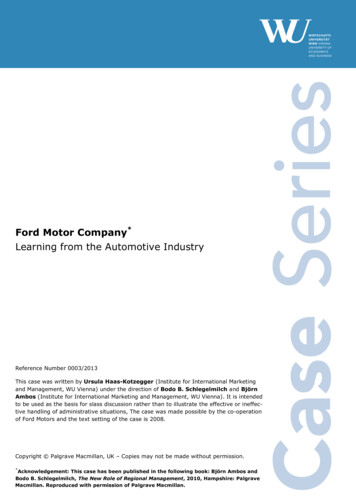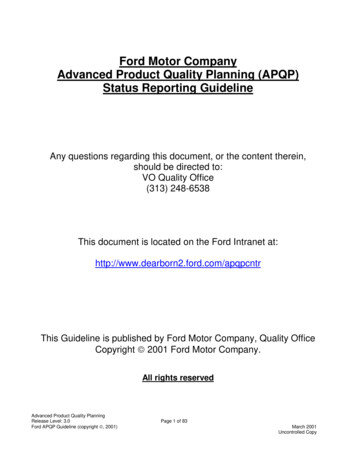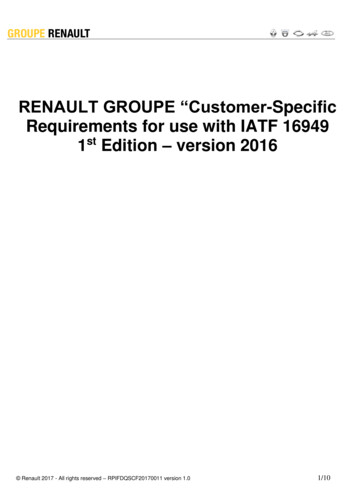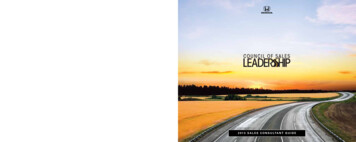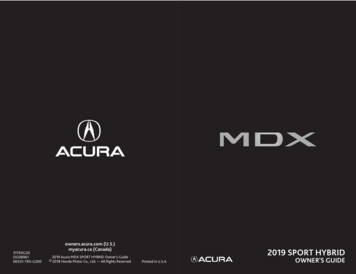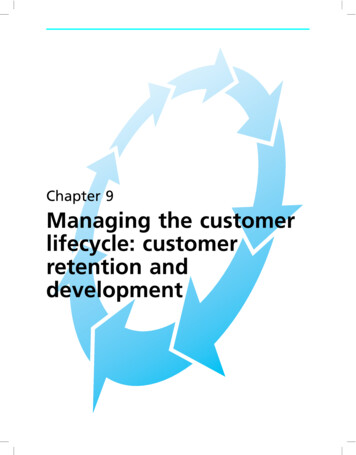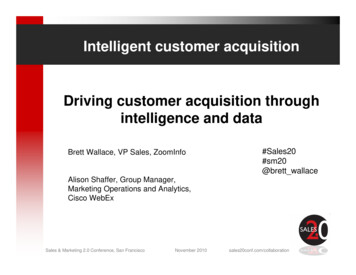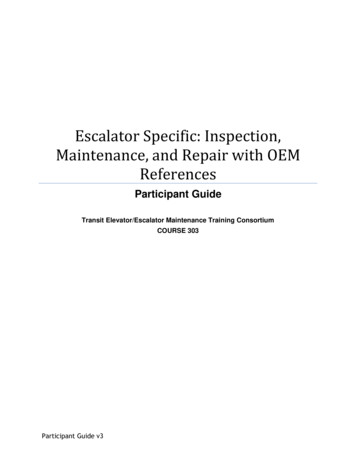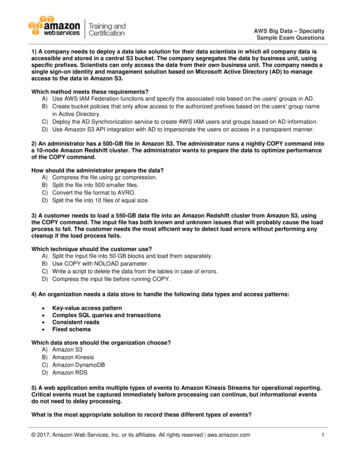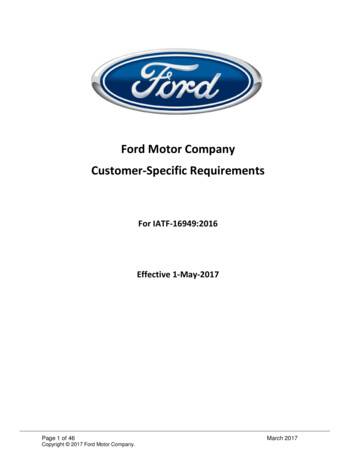
Transcription
Ford Motor CompanyCustomer-Specific RequirementsFor IATF-16949:2016Effective 1-May-2017Page 1 of 46Copyright 2017 Ford Motor Company.March 2017
Summary of IATF-16949 Sections 1 through 10 with customer specific contentContents1 Scope . 41.1 General . 42 Normative references . 53 Terms and definitions . 54 Context of the organization . 94.3Determining the scope of the quality management system . 95 Leadership . 115.35.1.1.1Corporate Responsibility . 115.1.2Customer focus . 11Organizational roles, responsibilities and authorities . 125.3.1Organizational roles, responsibilities and authorities - supplemental . 126 Planning. 126.1.2.3 Contingency plans . 127 Support. 137.1.3.1 Plant, facility, and equipment planning . 147.1.5 Monitoring and measuring resources . 157.1.5.1.1 Measurement system analysis . 157.1.5.3.2 External laboratory . 167.2 Competence . 167.2.1 Competence — supplemental . 167.5 Documented information . 177.5.2 Creating and updating . 187.5.3 Control of documented information . 197.5.3.2.1 Record retention . 198 Operation . 208.1 Operational planning and control . 208.2 Requirements for products and services . 218.2.1 Customer communication. 218.2.3 Review of the requirements for products and services. 21Page 2 of 46Copyright 2017 Ford Motor Company.March 2017
8.2.3.1.1 Review of the requirements for products and services — supplemental. 218.2.3.1.2 Customer-designated special characteristics . 228.2.3.1.3 Organization manufacturing feasibility. 238.3 Design and development of products and services . 238.3.1.1 Design and development of products and services — supplemental . 238.3.2.1 Design and development planning — supplemental . 248.3.3 Design and development inputs . 278.3.3.3 Special characteristics . 278.3.4 Design and development controls . 278.3.4.3 Prototype programme . 288.3.4.4 Product approval process . 288.3.5 Design and development outputs. 298.3.5.1 Design and development outputs — supplemental . 298.4 Control of externally provided processes, products and services . 308.4.1.2 Supplier selection process . 308.4.1.3 Customer-directed sources (also known as “Directed–Buy”) . 308.4.2.1 Type and extent of control — supplemental . 308.4.2.2 Statutory and regulatory requirements . 308.4.2.3 Supplier quality management system development . 318.4.2.4 Supplier monitoring . 328.5 Production and service provision. 338.5.1.2 Standardised work — operator instructions and visual standards . 338.5.2 Identification and traceability . 348.6 Release of products and services . 368.6.1 Release of products and services — supplemental . 368.6.2 Layout inspection and functional testing . 368.6.3 Appearance items . 368.6.6 Acceptance criteria. 378.7 Control of nonconforming outputs . 378.7.1.1 Customer authorization for concession . 379 Performance evaluation. 389.1 Monitoring, measurement, analysis and evaluation . 389.1.1.1 Monitoring and measurement of manufacturing processes . 38Page 3 of 46Copyright 2017 Ford Motor Company.March 2017
9.1.1.2 Identification of statistical tools . 399.1.2 Customer satisfaction . 409.1.2.1 Customer satisfaction — supplemental . 419.2 Internal audit. 429.2.2.3 Manufacturing process audit . 429.3 Management review . 439.3.1.1 Management review — supplemental . 439.3.2 Management review inputs . 4410 Improvement . 4410.2 Nonconformity and corrective action . 4410.2.5 Warranty management systems. 451 Scope1.1 GeneralIATF16949:2016, First Edition, Oct 1, 2016, “Automotive Quality Management SystemStandard,” ISO9001:2015, Fifth Edition, 09/15/15, “Quality Management Systems –Requirements”, and this document defines Ford Motor Company and Lincoln Motor Companyfundamental quality system requirements for organizations where automotive customerspecified parts, for production and/or service are manufactured. Third party certification toIATF16949 shall meet the following conditions:The certification scope must include both IATF16949 and the accompanying IATF16949 FordCustomer Specific Requirements,Certification Bodies currently contracted and recognized by an IATF Oversight office conductthe certification in compliance with the IATF recognized automotive certification scheme.The organization shall address all IATF16949:2016 requirements including the requirements ofthis document in the organization’s quality management system.References to “Ford” in this document apply to all of Ford Motor Company and Joint Ventureswith Ford and Lincoln Motor Company unless otherwise specified.The English language version of this document shall be the official version for purposes of thirdparty registration.Sanctioned translations of this document shall:Be for reference only.Reference the English version as the official language.Include Ford Motor Company in the copyright statement.Page 4 of 46Copyright 2017 Ford Motor Company.March 2017
Any other translations are not authorized.NOTES:Copies of this document are available from Ford Motor Company athttps://web.qpr.ford.com/sta/FordspecIATF.pdf and International Automotive Oversight Board athttp://www.iatfglobaloversight.org/ .2 Normative referencesNote: unless otherwise noted, all references listed throughout these Ford Specific Requirementsrefer to the latest edition.Any question about the applicability of a specific reference should be directed to theorganization’s Supplier Technical Assistance engineer.Note: Some hypertext links within this document may only be accessible on FSP (FordSupplier Portal) by organizations contracted by Ford Motor Company (typically Tier1). Lower tier organizations pursuing IATF 16949 registration may need to gainaccess to FSP (Ford Supplier Portal) or documents from FSP through a Tier 1.3 Terms and definitionsWhere inconsistent terminology exists between IATF 16949 and this document, this document shall takeprecedence. Otherwise, the definitions from IATF 16949 apply to this document.3.1 Active PartAn active part is one currently supplied to the customer for original equipment or serviceapplications. The part remains active until tooling scrap authorization is given by theappropriate customer activity. For parts with no customer-owned tooling or situations wheremultiple parts are made from the same tool, written confirmation from Ford Engineering andthe Buyer is required to deactivate a part.NOTE: For bulk material, “active part” refers to the bulk material contracted, not theparts that are subsequently produced from that material.3.2 Aftermarket PartsReplacement parts not procured or released by Ford Motor Company for service partapplications that may not be produced to original equipment specifications.3.3 APPCAverage Purchased Part Capacity: Capacity, is the organization’s capacity commitment (inpart count per week) to meet the Average Production Weekly capacity requirement andrecorded in Ford’s capacity planning systems GCP or MCPV.3.3 Average Production Weekly (APW)Average Production Weekly; capacity requirement for sustained production based on a 5 daywork week. Organizations: see the Capacity Planning Web Guide available thro
The names "Ford Motor Company" or "Ford" refer to the corporate entity comprising all brands under Ford Motor Company, including Lincoln. 3.14 Ford Engineering Ford Motor Company Product Development Engineering, including Program and non-Program



